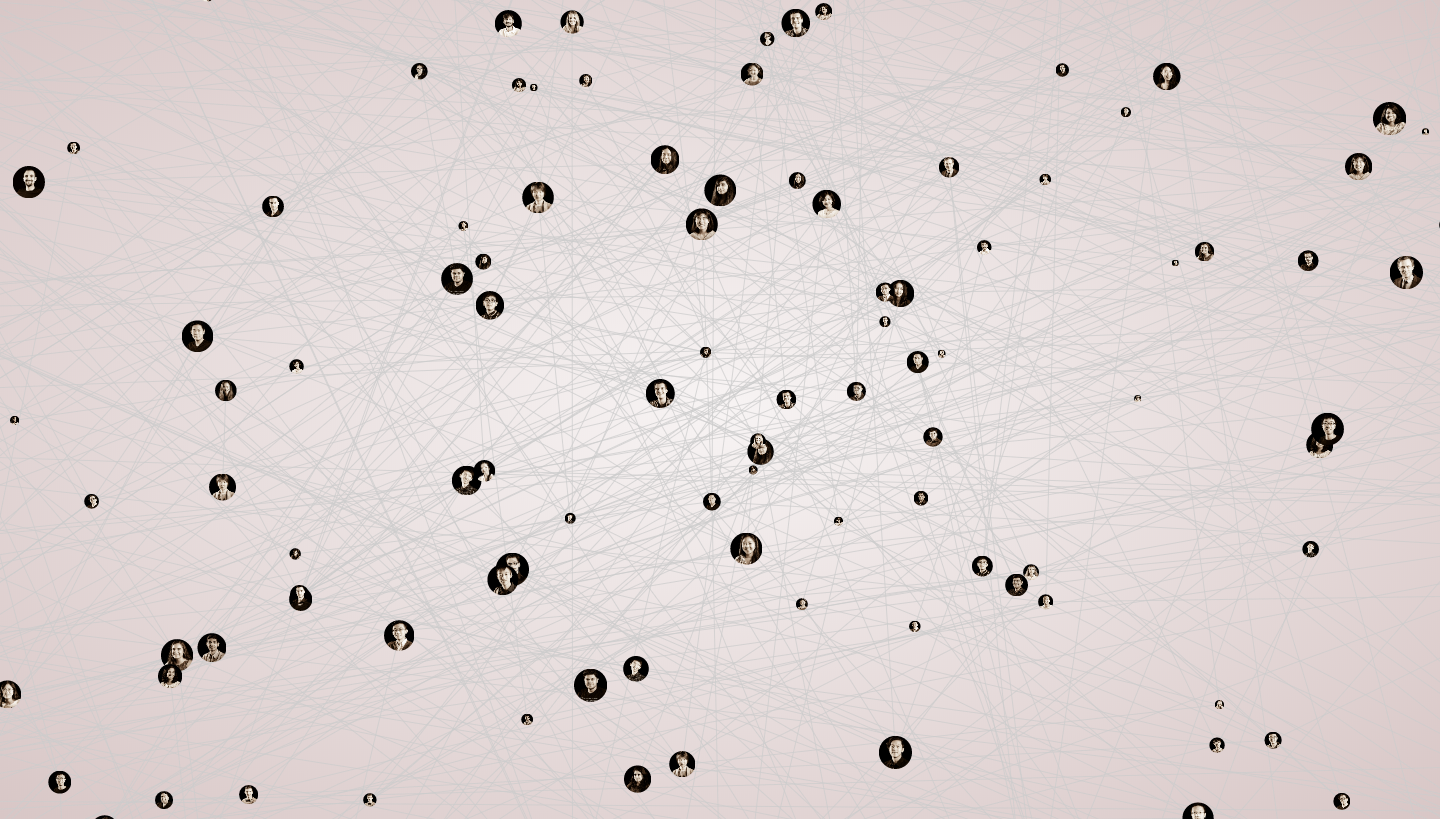The Work This Week:
With our client meeting scheduled for next Monday 10/15, the work this week consisted of continual development on our mosaic prototype. We also spoke with a handful of SMEs to gain further knowledge moving forward, and conducted some field research in the Tepper Building.
Continual Prototype Development:
We continued work on the selfie mosaic idea, in which visitors will be able to interact with a map, and then as you zoom in the pictures become interconnected pixels. The map itself has now been updated so that each pixel is a picture. The brightness of each pixel from the background image is analyzed, as well as the average brightness of the image, and then array of multiple images is displayed where the brightness is mapped to pixel size.
![]()
We are still looking to find a way to sort images by brightness and locate them to the right pixel.
Also, we have developed an overview of the possible screens that visitors will see through the experience.
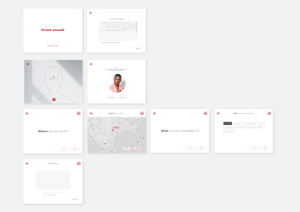
Talks with Anthony Daniels and John Dessler:
Anthony Daniels gave us some wonderful advice on lighting design and on some of the interactive elements we could have going forward.
On lighting, he suggested that we put gel filters behind the lamps that are in the space. These gel filters would not change the color of the lights, but they would dim them down, giving them a light grey color, and thus making them less harsh for visitors taking photos.
Then, with regards to the pillar, he suggested to put a plastic, or felt, collar onto the pillar. This collar could be CMU-themed and wouldn’t really hurt the pillar structurally. Then, we could hang a rotatable arm/wire across the space between the pillar and the wall to allow for as many directions from freedom as possible for camera movement, making the installation accessible for those with disabilities. This is something that we will discuss with our client next week.
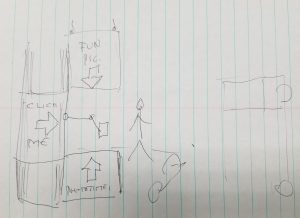
An alternative to this suggestion would be developing a stand, with adjustable height, that would stand in front of the pillar, facing the side wall, and hold the camera.
Speaking of the photography device, Anthony suggested that we stick with one means of taking photos – be that the tablet, a camera, or a webcam. Once we start adding more devices to the installation, it requires more maintenance and runs the risk of confusing less technologically savvy visitors. Having only one device also encourages people to take photos in collaboration with friends, which is a demographic that we noticed as persistent in our space (see “Field Research at Tepper”)
On the Projectors vs. Flat Screens debate, Anthony suggested using projectors, because “We’re so used to seeing flat screens. They look very much like product placement. Projectors will look more original.” If we do use projectors, we will probably end up repainting the wall of our space, and Anthony suggested that we paint it so that the original color (which would be maintained on the left side of the wall with the pictures already left) “melts” in with our new color.
Finally, with regards to our issue of consent and inappropriate photos, he suggested that we have a sign or carving in the space already, so that it doesn’t interrupt the visitor experience, but is clearly visible. A sign that says, for instance, “Filming here; you consent to this photography and appropriate photos. Appropriate ones will be removed.”
We also discussed the issue of inappropriate photos with John Dessler. He said that the simplest way is to have a person watch them (possibly from the nearby kiosk). The bottom line is that we shouldn’t redesign everything to work around it. John also supported the idea of using the pillar as a controller of some kind (i.e. using different backdrops or frames on it).
We also discussed about the Burton Morris project done at the ETC (an example of Burton Morris’s work can be seen below). In the project, there was a bubblegum machine in which the bubbles popped, but then they would stop when you got closer to it. And you would take pictures of yourself, and then see yourself in the backdrop of the image if got close enough to the exhibit.
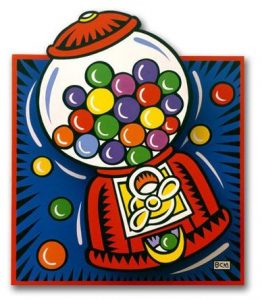
The key aspects of this project were that people wouldn’t use it without seeing other people using it, the flash got people’s attention, and the placement of the exhibit made a difference.
This led to our discussion about what can we do to in the idle state of the exhibit to get people into the experience. John said that once they’re in the experience, it shouldn’t be a problem, but that the initial engagement is the key to everything.
He suggested it to be more ingenious than a simple “screensaver thing on the wall.” Contrast works, as well as interactivity. John gave the example of an interactive display where water was coming down to the floor; and then when you walk towards, the water changes when you step on it. Similar to the Burton Morris project, this initial interactivity is more engaging than a simple screensaver. The key: having something react to something the visitor is doing.
An alternative would be to showcase photos on the wall, showing someone doing something cool and artistic, to then engage people. People would try to recognize people they know, and this would be particularly true with famous alumni.
Finally, we discussed what we would like our deliverable to look like, internally at the ETC. John said that, with a project like this, we need to show proof of something and sell the idea. He suggested to test our documentation with sample vendors and make sure that the design, and maintenance aspects that might be needed, is clear.
Field Research at Tepper:
Lastly, we spent some time in the Tepper Building this week, asking some students questions about how they use the space, and conducting observational data on people using the space. A sample sheet of one of these questionnaires we handed it can be found below:
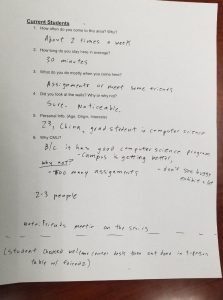
From this research, a few things became clear: students mainly use the space as a quiet spot to study, and they only sometimes glance over to the space we’re working with. Most students think that our space is for prospective students only and therefore don’t hang out there a whole lot, instead preferring to sit at the tables by the window, or by the stairs. Most of the students we talked to discussed spending time in the space with friends.
We also spent some time observing prospective students on Friday, during the busiest parts of the tour week. Students came with their families and sat all around the space while waiting for the tour. It became clear, by the amount of head-fidgeting, how nervous these prospective students are, and that if we give them something to capture their attention, it will. Parents seem more interested in talking to the ambassadors and people giving the tour, but a few of them (especially the dads) were seen glancing around and observing the space. Side note: one of the moms asked a tour guide “do you feel like you’re really in the city here in Pittsburgh?” which might be something we want to look into further with regards to questions.
Once the tour started, there wasn’t a whole lot of time lingering in the space, so the moments when these guests will use our installation will most likely come when they are waiting for the tour to begin.
A few of us will spend some time next week actually going on one of these tours to find out more information.
Next Week:
For our client meeting, we are preparing a presentation that will have a measured floorplan layout of the space, as well as a rough budget plan, to ask for feedback on in addition to the work already done.
We will also start preparing for 1/2 presentations, which will be held the week after next.
Lastly, we hope to have our prototype workable enough by next week so that we can playtest it, roughly, with fellow ETC students and gather more data going forward into 1/2 presentations.
